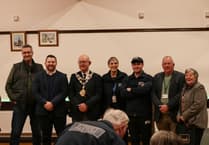Modern life changes so rapidly and occupations change, many trades once carried out by Pembroke people are now lost. Mel Phillips, chairman of the museum's committee, suggested this as a theme for one of our exhibits in the museum. She really is a mine of information and has provided me with the material for this week's article on the subject of 'Pembroke's old and smelly trades'. The first of these, I have to admit, I was totally unaware of.
Scavengers and gong farmers
We complain a lot nowadays about dog poo - there are still many irresponsible dog owners who do not pick it up. Going back in time, however, Pembroke was in a far worse state with so much 'dung and other filth' covering the streets that the council in 1723 empowered the mayor and two aldermen to appoint a 'scavenger' to clean up the town. Imagine what life must have been like then with no mains drainage systems, when dunghills blocked streets, cesspits overflowed and sewage fouled the rivers - the only sewage treatment was its removal by these cleaning officials called Scavengers, which has a somewhat different meaning today. It was then a reputable profession and the would be Scavenger would have to take an oath, which went like this: "Ye shall swear that ye shall diligently oversee that the pavements within your ward be well and sufficiently repaired, and not made too high in annoyance of your neighbours; And that the Ways, Streets and Lanes, be cleansed of Dung, and all manner of filth, for the honesty of this city: and that all the chimneys and furnaces be of stone or brick, sufficiently and defensively made against peril of fire. And if ye find any to the contrary, ye shall show it to the Alderman of your Ward, so that the Alderman may ordain for the amendment thereof. And thus ye shall do, as God you help. God save the King." Wealthier townspeople employed contractors called 'gong-farmers' or 'nightmen' to remove their sewage. Gong was the old name for a toilet. The sewage might be sold to vegetable growers, buried in pits or (more often) be tipped into the nearest river. The rat catcher
Think of sewage and you think of rats - this little critter of the black variety was responsible for bringing the plague, or Black Death to Pembroke in 1349, although it was the flea they carried which actually carried the infection. The plague was a dreadful scourge killing off a third of the population of the country: Pembroke like most other places fared badly. Rats were killed because they ate human food, but their role in spreading infection was still unknown. A familiar figure on the streets was the private enterprise rat-catcher. We still have rat catchers of course - although now you have to 'phone the county council and ask for the rodent control officer.
The Tanner
Many of Pembroke's old and smelly occupations took place on The Commons, outside of the town walls and that area must have been very unpleasant. An industrial estate developed here with a Gasworks, limekiln, slaughter house (where the library and Information Centre now is), a smithy and iron foundry (now the community centre) and a tannery. The Youth Club bears the name The Tanyard, after the Tanner's premises which were situated there. Mel made all this sound very smelly indeed: "The Tannery smelled of festering cowhides, rancid fat, rotten meat, and dog mess. The Tanners used a foul substance called Album Grecum to polish their saddles and in the tanning of hides. Album Grecum was the posh name for dog's white excrement known to the Tanners as 'Bate.' Someone had discovered that if you added water to this vile mess and stirred it around, you got evil smelling gravy that you could then use to pour over the hides in order to soften leather. The hides were then left to ferment in the Bate for a few weeks. When this procedure was finished, the soup was rubbed into saddles or any type of leather, and the result was a glorious shine.
Collectors of Pure
"However, the Album Grecum had first to be found and the Tanner gave this job to the Collectors of Pure. "This was a strange and pretty name for the most disgusting of jobs. Pure was another name for dogs white excrement. The Collectors of Pure consisted of a motley band of tramps, old crones and street urchins who would earn a halfpenny for every bucket of Pure that was returned to the Tanner."
The Rabbit Factory
The rabbit factory was situated on the site of the old Pembroke Tanyard. The rabbit skins were tanned there before being made into fur gloves. The premises belonged to Mr. George Wheeler who owned two rabbit factories, one being 'up the line.' Local rabbit catchers supplied the rabbits. My grandfather being a poacher probably supplied a few! The workers were employed to skin the rabbits and then store their carcases in a large freezer until they could be transported to Mr. Wheeler's second factory. Mr. Fred Dando worked at the factory as a skinner and it was said that he could skin and paunch a rabbit in 10 seconds! At one time, there was to be a competition between him and a skinner from the other factory as to who could skin a rabbit the fastest, but the event never materialised! Unfortunately, the business went into decline and was forced to close when the government introduced myxomatosis, to control the rabbit population. The disease decimated the population so greatly that nine out of ten rabbits were exterminated. The factory closed in the 1950s."
Quarrying and lime burning
Situated on a bed of limestone, quarrying was an important occupation in Pembroke, and there are many ex quarries to be seen. Along the Pembroke River, you can see the inlets and jetties used by the boats to take away the stone. Associated with the quarrying of limestone are the limekilns, some of which are still in evidence, the most accessible being the one on The Commons near the bottom of the New Way. There is a good one also by India Row, Monkton, but on attempting to see it I was attacked by an Alsation dog so did not manage to get a photograph, I retreated nursing my wounds. Mel told me that her grandfather was a lime burner. "He drove the lime cart for Sir Thomas Meyrick on the Bush Estate. Almost everyone in Pembroke worked for the Meyricks, of Bush, and my grandfather and his family were no exception. They lived in a tied cottage on the estate. "Burning lime was a terribly dangerous job. You can still see the lime-kilns dotted here and there throughout Pembroke. Limestone was taken from Catshole Quarry where it was cut into small pieces, then driven to the lime kilns. A fire was lit underneath the kiln and the small limestone pieces were loaded in. The heat which the kiln gave off was unbearable. The lime burned in the kiln and was raked out from the bottom. This is where it became dangerous. Pokers and rakers were employed to remove the lime, but great care was needed in case the lime blew into the Raker's eyes. Lime in the eyes almost certainly spelt blindness. "The lime was used for a variety of things. The building trade used it instead of cement and it was also used to restore the Ph balance of a sour soil and made the earth into something more manageable for the farmer. Slaked lime was used as a white wash for cottages whilst lime wash on the inside walls of the house kept the bugs away."
Contact
If you have any stories, photographs or feedback for this column, please contact me, Linda Asman, on 01646 622428, email [email protected]">[email protected] and visit our website http://www.pembrokeandmonkonhistory.org.uk">www.pembrokeandmonkonhistory.org.uk





This article has no comments yet. Be the first to leave a comment.